
Summarize Content With:
Quick Summary
There might have been times when you had to do the talking even when you didn’t like it. It could also have been situations when you would have just wanted to end those calls, as they can be quite overwhelming. But did you know there’s a tool that can help you get over these calls and deal with them efficiently, just like you want it?
In this blog, we are going to know about these magic tools, which are AI voice agents, what it is, how they work, and how you can build your own.
Introduction
An AI voice agent is a kind of voice AI assistant which helps you operate your call in a more efficient way and utilize time effectively. Reducing waiting time and enhancing customer experience with quick support have become an easier task. It utilizes various technologies such as speech-to-text, text-to-speech, and even large language models. Helps deliver an enhanced natural conversation experience with its advanced knowledge.
What is an AI Voice Agent?
An AI Voice Agent is a software that can also be referred to as an AI virtual assistant that is typically powered by artificial intelligence, that allows for the most natural and conversational interactions through spoken language. Basically, it’s an AI call assistant, which enables machines to perceive human language and respond to that in a similar way.
Key Components of AI-powered voice assistant
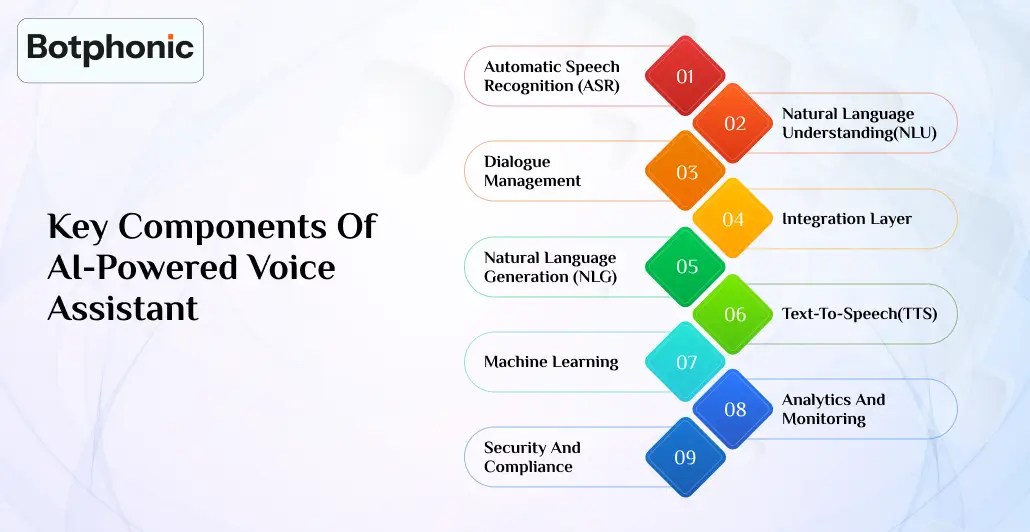
1. Automatic Speech Recognition (ASR): It’s the first step that AI needs to understand the user’s query.
2. Natural Language Understanding(NLU): This step is used for analyzing the context and detecting the user’s intent to define the entities.
3. Dialogue Management: It enables you to manage the direction of conversation and ensures that the interactions are logical.
4. Integration Layer: This helps you connect to the external systems such as CRMs, databases, and other relevant platforms. It helps retrieve and update the data in real-time.
5. Natural Language Generation (NLG): NLG converts the organized data shared by the system into normal human-readable language, which ensures that the bot is speaking in a natural and user-friendly tone.
6. Text-to-Speech(TTS): TTS helps transform the generated text response shared by the system into audio that is shared by the system to the user.
7. Machine Learning: This allows the assistant to get smarter with the responses as it’s learning from the interactions continuously.
8. Analytics and Monitoring: Monitoring helps you track usage and identify the pain points and drop-offs. It helps optimize the assistant’s performance.
9. Security and Compliance: Ensuring your data privacy, encryption is one of the major tasks, which is critical for trust and especially important in certain sectors such as healthcare, finance, and even legal sectors.
How Does an AI Voice Agent Work?
Now that we know about an AI voice agent, how about we also know how it works and what it does to give us the response that we need.
Let’s get into this with a simplified breakdown of how it works.
1. Voice Input
To start with the responses the system first need the input from the user, the agent’s microphone catches your voice to process it further
2. Speech Recognition
A specified text is generated through the user’s input using Automatic Speech Recognition.
3. Natural Language Understanding
Then the AI acknowledges the intent and starts extracting details from the database to curate the key details.
4. Backend Integration
The voice agent then proceeds to integrate systems such as CRM, management details or even from the calendars and other supported databases. It sorts the data based on the user’s intended request.
5. Response Generation
The AI proceeds to generate an appropriate response using Natural Language Generation.
6. Text-to-Speech (TTS)
The response text is then processed to get transformed into natural-sounding speech and gets played to the user for appropriate response.
7. Continuation of Conversation
After the relevant response the agent waits for the user’s next input to continue the conversations and it gets repeated every time the user uses conversational voice AI.
Just so you know, AI’s work doesn’t just end after a single conversation it continues to learn from the interactions done with the user to improve its accuracy and detect the issues that might have been occurring.
Are AI Voice Agents The Future Of Call Centers?
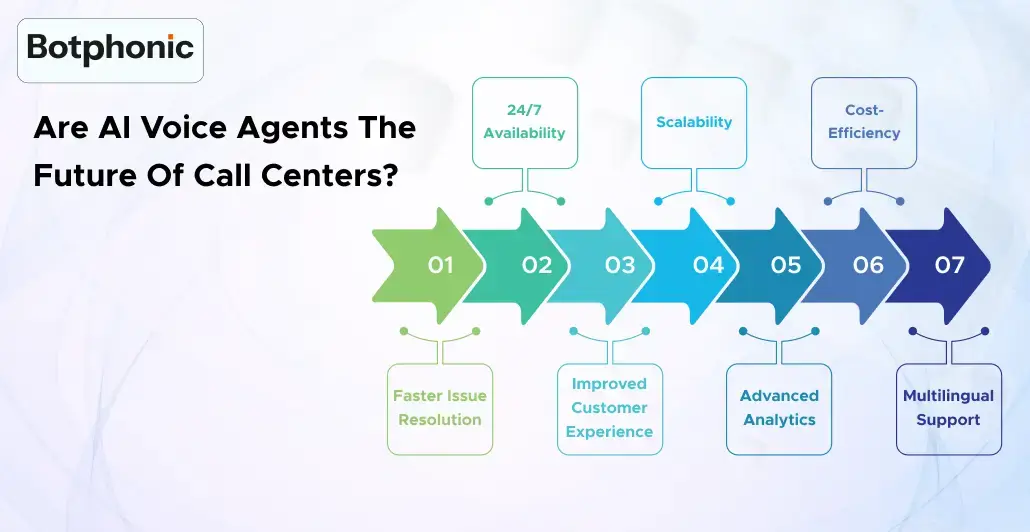
While it’s not possible to replace humans all over from the industry, artificial intelligence voice assistants are here only to help with the task reductions and transform the way customer service is delivered. Let’s see the major reasons why AI voice agents are shaping the future of call centers
1. 24/7 Availability
AI voice agents are always present when you need it, and never get tired of even if they are alone and have been working for hours. They help you handle calls even if it’s outside business hours.
2. Scalability
AI is made to scale your work without making you feel burdened or even stressed about missing any single opportunity. They can handle thousands of calls simultaneously without having you to worry about any additional support.
3. Cost-Efficiency
Voice assistant AI helps you reduce operational costs by automating tasks that don’t really need your attention. It works on one-time set-up and lower long-term labor.
4. Faster Issue Resolution
With a vast knowledge base and integrations, it helps in quick response and reduces average handling time significantly.
5. Improved Customer Experience
Sharing personalized responses with users by using caller data and longer IVR menus enhances consumer experience.
6. Advanced Analytics
Providing insights by tracking call intent, sentiment, and satisfaction rate helps you optimize AI effectively.
7. Multilingual Support
Supporting global customers has never been easier, it can access multiple languages easily and helps customers who are not frequent with other languages.
Even the best AI voice companies are only here for enhancing productivity, reducing costs, and to improve customer experience effectively.
Voicebot Vs Voice Agent Vs IVR
Voicebot: This is an AI or rule-based bot that typically interacts in limited voice conversations, and it might not be able to maintain the context.
Voice Agent: It is an advanced form of a voice bot, which is capable of natural, contextual, and even smart conversations.
IVR: It follows a traditional phone system that routes calls through fixed menus.
Comparison Table to Know Better:
| Aspect | IVR (Interactive Voice Response) | Voicebot | Voice Agent (AI-Powered) |
| Definition | Menu-based phone system using DTMF tones or basic voice commands | Rule-based or AI-driven conversational interface | Advanced voicebot with dynamic, AI-powered capabilities |
| Technology | DTMF tones, basic speech recognition | NLP + Rule-based logic | NLP + NLU + Machine Learning + Contextual AI |
| Input Type | Keypad (press 1, 2…) or fixed voice commands | Free-form voice or text | Natural, conversational voice input |
| Output Type | Pre-recorded or TTS responses | Predefined or AI-generated responses | Dynamic, contextual speech via advanced TTS |
| Conversation Flow | Linear, menu-driven | Slightly flexible, often script-based | Highly dynamic and multi-turn conversational |
| Context Awareness | No | Limited (in some platforms) | Full memory of previous turns and context |
| Personalization | None | Limited (based on rules) | Personalized using CRM or user history |
| Use Case Complexity | Simple tasks (e.g., routing, checking hours) | Moderate (e.g., appointment booking, simple FAQs) | Complex tasks (e.g., order tracking, tech support) |
| Integration Support | Low to Moderate | Moderate | High; integrates with APIs, CRMs, ERPs, etc. |
| Learning Capability | Static | Some rule-based learning | Learns from interactions, improves over time |
| Setup Complexity | Low | Moderate | High (but scalable and efficient long-term) |
| Customer Experience | Basic, often frustrating | Improved over IVR | Human-like, natural, engaging |
| Cost (Initial) | Low | Moderate | Higher (but better ROI in scaling scenarios) |
How To Create and Implement Your Voice Agent?
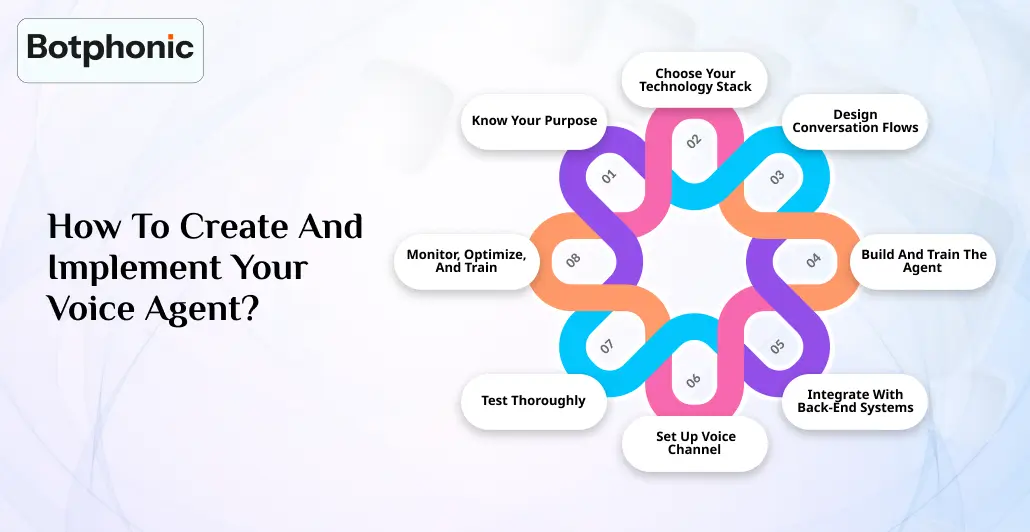
Whatever you are thinking of creating,you should always start with the basics and know what the issue is and why you really need it but as it’s voice AI agent, we might have an idea of why we need it but let’s get to know about this in detail and know how to create an AI voice agent.
Here’s the steps that you really need to follow to get what you want:
1. Know Your Purpose
Before starting, always ask yourself a few questions such as “what is the problem that AI is solving and your agents are not able to?”, “Who are you users?” and other questions that might make your doubts clear.
2. Choose Your Technology Stack
Now to choose a platform if your basics are clear and you know what issues are occurring, select a technology stack such as ASR that you need which turns the user’s speech into text or NLU to understand the user’s intent.
3. Design Conversation Flows
Create an outline from the user’s common questions and intents what they want to know. And most importantly, include an escalation path towards human reps for easy coordination.
4. Build and Train the Agent
And now it’s your time to train your agent with all the data that you have gathered, define the intent, add training phrases, and use real-life queries to improve its understanding.
5. Integrate with Back-End Systems
Link your voice agent to other systems which will enhance its efficiency, such as CRMs, databases, payment gateways, and other relevant systems.
6. Set up Voice Channel
Add options or decide on a channel where you want to launch your AI call assistant, so that the user can have access and connect with it.
7. Test Thoroughly
Ensure to test your agent thoroughly by stimulating real conversations and testing various accents, tones, and even interruptions to know if there’s any obstacle coming through.
8. Monitor, Optimize, and Train
Track the performance rate of the system, such as call duration, resolution rate, and customer satisfaction. And make sure to train your system regularly based on insights.
Common Mistakes to Avoid When Creating an AI Voice Agent
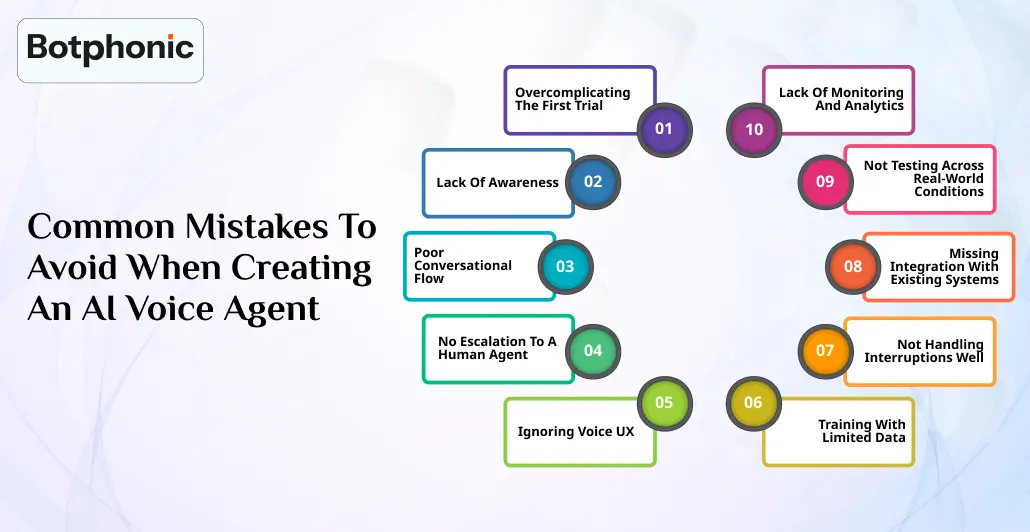
Creating an AI can be next-level crazy for you, but there are several mistakes that can lead you to crash. And rather than giving you positive output, it might lead to poor performance, frustrated users, or even project failure.
Let’s get to know what these bugs are and how we can avoid them:
1. Overcomplicating the First Trial
Don’t try to do too much at once; start with a few high-impact and well-structured queries. And scale gradually after going through tests.
2. Lack of Awareness
Voice agents might forget past inputs and cause user frustration by making them repeat themselves.
Avoid it by using a dialogue manager that can easily retrieve conversation history and even support multi-turn conversations with context tracking.
3. Poor Conversational Flow
While creating a voice AI solution, it is possible that you have given it a robotic and scripted flow that doesn’t make it feel natural.
Avoid doing it by including small talk and even fallback responses. You can design a natural and human-like conversational flow for better results.
4. No Escalation to a Human Agent
Not providing a path for users to interact with human reps can be a little frustrating for them, as there are some issues that need an emotional touch with a little hint of trust.
Avoid it by including smart escalation triggers and ensure to mention an option of “talk to a human.”
5. Ignoring Voice UX
If you are using a monotone or unnatural TTS, it might frustrate the user.
Choose an AI voice that sounds real and feels a soothing rather sharp voice.
6. Training With Limited Data
Training your bot with a few examples and only using your own assumptions for the same might be a big mistake.
You can avoid it by using a real user interaction, with relevant data. Ensure to continuously refine and update the data for better training.
7. Not Handling Interruptions Well
The bot might fail to understand the intent if a user falls silent or interrupts the system.
Avoid it by implementing interruption detection and silence handling logic.
8. Missing Integration with Existing Systems
The bot is not able to access the user data or even perform real actions in real time,
Integrate it with CRM, payment gateways, or even with APIs and Calendars.
9. Not Testing Across Real-World Conditions
Only testing the bot in ideal conditions and not making it face accent challenges and background noise can be a little illogical, as users are not always in favourable conditions.
Test it with users of different languages, accents, and devices to avoid this crucial mistake.
10. Lack of Monitoring and Analytics
Never forget that you have launched an AI voice bot, ensuring to track call success rate, fallbacks, and even feedback to improve.
Use Cases and Applications of AI Voice Agent
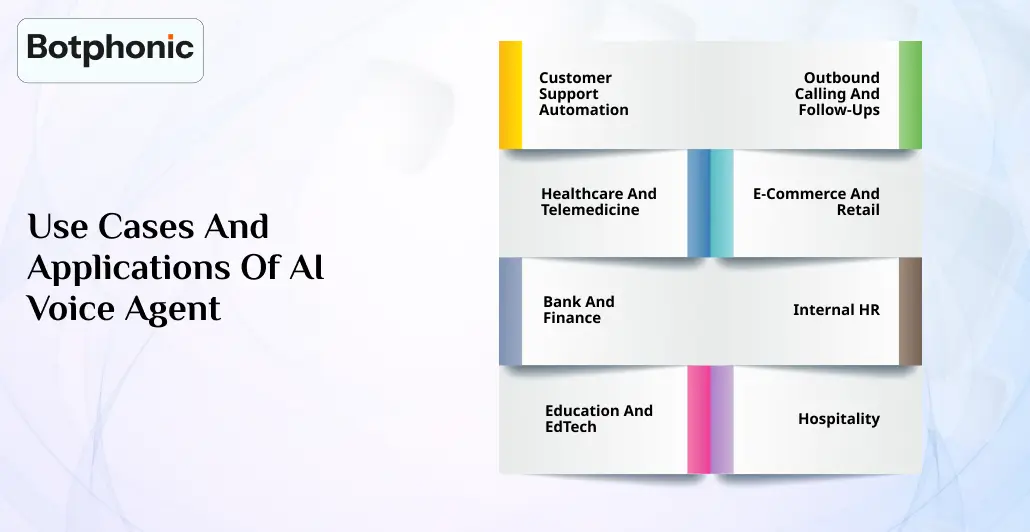
There are numerous voice AI companies and software that are helping other organizations with their efficiency and helping them grow efficiently.
1. Customer Support Automation
AI voice agent can easily handle routine customers and help them with queries without any breaks and reduce wait times.
They can handle tasks such as order tracking, billing inquiries, password resets, and many more. You just need to set it up and watch it grow your support.
2. Outbound Calling and Follow-ups
Voice agents are designed to approach customers without any hesitation and help you get your potential lead. It can be effectively used for appointment reminders, payment follow-up, and many more.
They help you scale your outreach without needing you to expand your call center team.
3. Healthcare and Telemedicine
You can always use an AI voice that sounds real, which will help you streamline interactions and help you with routine tasks. Integrate AI voice bots to help you with appointment reminders, prescription refill requests, and even post-visit follow-up calls.
4. E-commerce and Retail
These bots can assist your customers with transactional and support needs. It can be used for product availability inquiries, delivery status updates, and even personalized 24/7 support.
5. Bank and Finance
AI can help you with improving self-service in a most secure and compliant way. It can perform various tasks such as balance checks and transaction history, provide loan application assistance, and even with fraud alerts.
6. Internal HR
These bots can be effectively used by employees for support and efficiency. It can help you with IT troubleshooting, leave application, and policy queries.
7. Education and EdTech
Voice agents can always help you and your pupil with their instant support and ease of access.
For instance, admission FAQs, class schedules, fee status, or even test status.
8. Hospitality
Streamline customer interactions in industries where there are high volumes of calls. It can be used for flight or hotel booking, real-time travel updates, and even for lost item reporting.
AI voice agents have become a business essential. It helps you provide instant support and personalized engagement to scale faster and smarter.
Conclusion
Calling repetitively and answering similar queries can be as exhausting and time-consuming. But with AI voice agents it has become easier to handle even large volumes of calls within a fraction of a second. These agents are here to enhance productivity rather than replacing them. It helps with various tasks such as customer handling, follow-ups and even automating internal processes. If not selecting a pre-defined one, you can always build your own voice bot. Implement these miraculous tools in your operations and work with the future of voice interaction.

